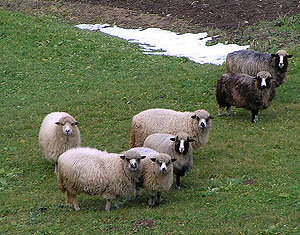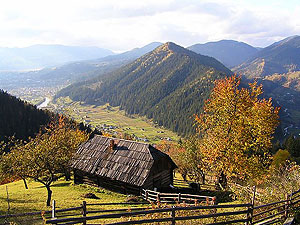- About Ukraine
- Hutsuliya
- Rest and Tourism
- Photograph Album
- Library
- Hutsul Legends
- Hutsul Customs and Traditions
- The Carpathian Pastoral
- Hutsul’s Hospitality and Politeness
- Hutsul Wedding
- The Wedding Day In Kosiv
- Hutsul Holidays and Traditions
- Hutsul Folk Art
- Feed
- Store
When you say “Carpathians” to any Ukrainian from outside this region, they will instantly have a picture in their minds of a Hutsul, a local dweller, wearing his distinctive hat, smoking an elaborately curved pipe, and curling his long mustaches. Behind him is a traditional wooden cottage set in a green meadow that is sprinkled with wildflowers and cut through by a stream of clear water.

There may be a few haystacks and some horses or contented sheep grazing on the lush grass that stretches up the hill to a line of spruce trees. Beyond this line of trees rise the undulating contours of the Carpathians and above them is a blue sky — lazily crossed by a few clouds.
During different seasons, the hills are naturally abundant with food — raspberries, blackberries and strawberries all grow wild and there is a rich variety of mushrooms to be collected every summer and autumn. Water is everywhere. The mountain slopes have innumerable small streams flowing down and, sometimes, making the only sound to be heard in the silence that enfolds the entire scene.
Occasionally the tinkling of sheep or goat bells and the whistling of a shepherd break this silence. Perhaps the most important part of this scene is the mountains themselves. But even calling them mountains seems something of a misnomer. Other mountains are daunting, but the Carpathians are somehow reassuring in the regular rise and fall of their contours. Rounded and gently curved, having been smoothed by the forces of nature, over countless eons of time, they surround you with a protective rather than an isolating air. The picture of tranquillity.

A flat horizon inevitably leads people to think about the future, to worry about life. In the Carpathians you are screened from such thoughts and you are able to live for the day. If you spend a few days in this region you will see a scene that actually does conform very closely to this ideal image. But, if you stay for a bit longer, you begin to appreciate the reality that lies beneath.
The contours of the hills look gentle but walking up them soon makes you realize that they nevertheless are extremely high. The constant steams of water which visitors find so appealing come from the outside world for 4–5 month in winter. And while everyone knows about the distinctive pipes the Hutsuls smoke, fewer have heard of the “Carpathian smokes”, dense mists which blanket the area for several days at a time. The pastoral idyll has a very real edge to it and this has shaped the attitude of people who have lived in this area for generations.
Their conversations casually include remarks such as “when we were under the Poles” or “when we were under the Austrians” and “when we were under the Russians”, indicate their positive outlook of themselves as autonomous and also a belief that their ways will endure regardless of outside influence. Perhaps this is why tourists really amuse the locals with cameras trying to get a true picture of the region merely through taking a picture.

Photographs are as unrealistic as trying to rule the area from the outside. Seeing a visitor even posing for a photograph, may well make a welcome breaker from day-to-day tasks, but the locals are confident: the visitors will go and then we will go on as normal.

